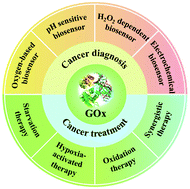当前位置:
X-MOL 学术
›
Chem. Soc. Rev.
›
论文详情
Our official English website, www.x-mol.net, welcomes your
feedback! (Note: you will need to create a separate account there.)
Catalytic chemistry of glucose oxidase in cancer diagnosis and treatment
Chemical Society Reviews ( IF 40.4 ) Pub Date : 2018-07-19 00:00:00 , DOI: 10.1039/c7cs00891k Lian-Hua Fu 1, 2, 3, 4, 5 , Chao Qi 1, 2, 3, 4, 5 , Jing Lin 1, 2, 3, 4, 5 , Peng Huang 1, 2, 3, 4, 5
Chemical Society Reviews ( IF 40.4 ) Pub Date : 2018-07-19 00:00:00 , DOI: 10.1039/c7cs00891k Lian-Hua Fu 1, 2, 3, 4, 5 , Chao Qi 1, 2, 3, 4, 5 , Jing Lin 1, 2, 3, 4, 5 , Peng Huang 1, 2, 3, 4, 5
Affiliation

|
Glucose oxidase (GOx) is an endogenous oxido-reductase that is widely distributed in living organisms. Over recent years, GOx has attracted increasing interest in the biomedical field due to its inherent biocompatibility, non-toxicity, and unique catalysis against β-D-glucose. GOx efficiently catalyzes the oxidization of glucose into gluconic acid and hydrogen peroxide (H2O2), which can be employed by various biosensors for the detection of cancer biomarkers. Various cancer therapeutic strategies have also been developed based on the catalytic chemistry of GOx: (1) the consumption of glucose provides an alternative strategy for cancer-starvation therapy; (2) the consumption of oxygen increases tumor hypoxia, which can be harnessed for hypoxia-activated therapy; (3) the generation of gluconic acid enhances the acidity of the tumor microenvironment, which can trigger pH-responsive drug release; (4) the generation of H2O2 increases the levels of tumor oxidative stress, and the H2O2 can be converted into toxic hydroxyl radicals that can kill cancer cells upon exposure to light irradiation or via the Fenton reaction. More importantly, GOx can be combined with other enzymes, hypoxia-activated prodrugs, photosensitizers or Fenton's reagents, to generate multi-modal synergistic cancer therapies based on cancer starvation therapy, hypoxia-activated therapy, oxidation therapy, photodynamic therapy, and/or photothermal therapy. Such multi-modal approaches are anticipated to exert a stronger therapeutic effect than one therapeutic mode alone. Thus, maximizing the potential of GOx in a biomedical context will offer novel clinical solutions to diagnose and treat cancer. In this tutorial review, we introduce the recent advances of GOx in cancer diagnosis and treatment. We then emphasize the design principles and biomedical applications of GOx-based biosensors and cancer therapeutic approaches. Finally, we discuss the challenges and future prospects of GOx-based catalytic systems in biomedicine.
中文翻译:

葡萄糖氧化酶的催化化学在癌症诊断和治疗中的作用
葡萄糖氧化酶(GOx)是一种内源性氧化还原酶,广泛分布于生物体中。近年来,由于其固有的生物相容性,无毒性和独特的针对β- D-葡萄糖的催化作用,GOx在生物医学领域引起了越来越多的兴趣。GOx有效催化葡萄糖氧化为葡萄糖酸和过氧化氢(H 2 O 2),可被各种生物传感器用于检测癌症生物标志物。基于GOx的催化化学,还开发了各种癌症治疗策略:(1)葡萄糖的消耗为癌症饥饿治疗提供了另一种策略;(2)耗氧增加了肿瘤的缺氧,可用于缺氧激活治疗;(3)葡萄糖酸的产生增强了肿瘤微环境的酸度,可以触发pH响应型药物的释放;(4)H 2 O 2的产生增加了肿瘤的氧化应激水平,并且H 2 O 2可以转化为有毒的羟基自由基,这些羟基自由基在暴露于光照射或通过芬顿反应。更重要的是,GOx可以与其他酶,低氧激活的前药,光敏剂或Fenton试剂结合使用,以基于癌症饥饿疗法,低氧激活疗法,氧化疗法,光动力疗法和/或光热疗法产生多模式协同癌症疗法。治疗。预期这种多模式方法比单独一种治疗模式具有更强的治疗效果。因此,在生物医学背景下最大化GOx的潜力将为诊断和治疗癌症提供新颖的临床解决方案。在本教程的回顾中,我们介绍了GOx在癌症诊断和治疗中的最新进展。然后,我们强调基于GOx的生物传感器和癌症治疗方法的设计原理和生物医学应用。最后,
更新日期:2018-07-19
中文翻译:

葡萄糖氧化酶的催化化学在癌症诊断和治疗中的作用
葡萄糖氧化酶(GOx)是一种内源性氧化还原酶,广泛分布于生物体中。近年来,由于其固有的生物相容性,无毒性和独特的针对β- D-葡萄糖的催化作用,GOx在生物医学领域引起了越来越多的兴趣。GOx有效催化葡萄糖氧化为葡萄糖酸和过氧化氢(H 2 O 2),可被各种生物传感器用于检测癌症生物标志物。基于GOx的催化化学,还开发了各种癌症治疗策略:(1)葡萄糖的消耗为癌症饥饿治疗提供了另一种策略;(2)耗氧增加了肿瘤的缺氧,可用于缺氧激活治疗;(3)葡萄糖酸的产生增强了肿瘤微环境的酸度,可以触发pH响应型药物的释放;(4)H 2 O 2的产生增加了肿瘤的氧化应激水平,并且H 2 O 2可以转化为有毒的羟基自由基,这些羟基自由基在暴露于光照射或通过芬顿反应。更重要的是,GOx可以与其他酶,低氧激活的前药,光敏剂或Fenton试剂结合使用,以基于癌症饥饿疗法,低氧激活疗法,氧化疗法,光动力疗法和/或光热疗法产生多模式协同癌症疗法。治疗。预期这种多模式方法比单独一种治疗模式具有更强的治疗效果。因此,在生物医学背景下最大化GOx的潜力将为诊断和治疗癌症提供新颖的临床解决方案。在本教程的回顾中,我们介绍了GOx在癌症诊断和治疗中的最新进展。然后,我们强调基于GOx的生物传感器和癌症治疗方法的设计原理和生物医学应用。最后,











































 京公网安备 11010802027423号
京公网安备 11010802027423号